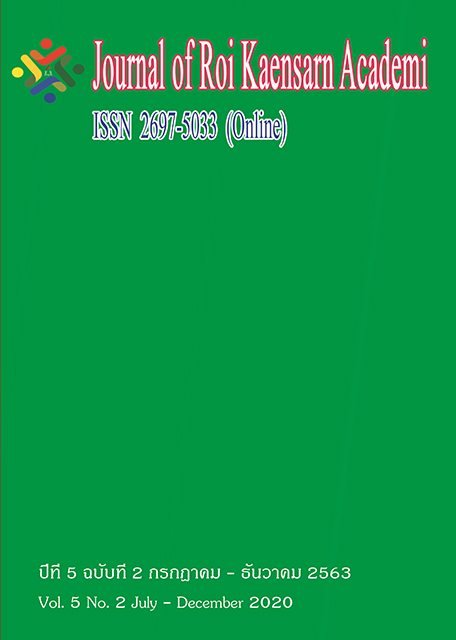Four Noble Truths : Path Leading to Cessation of Suffering
Main Article Content
บทคัดย่อ
The main objective of the academic article was to study the Buddhist principle of Four Noble Truths (Ariyasacca) as an absolute path leading a man, regarded as a traveler in the cycle of transmigration (Saṅsāravaṭṭa), to the cessation of suffering. The process of the study was conducted to describe in details by separating Ariyasacca into four sectors: suffering (Dukkha), the origin of suffering (Samudaya), the cessation of suffering (Nirodha) and the path leading to the cessation of suffering (Magga). The suffering consisted of two types: physical and mental. However, the suffering resulted from all defilements was counted as the suffering in Buddhism, which was summarized by the Buddha that all the five aggregates were sufferings. Having been known by a person, suffering was taught not to cling to or not to adhere to, but the true cause of suffering, regarded as a severe problem of human life, was taught to penetrate profoundly to discover problem resolutions. In conclusion, craving (Taṇha), described as craving for sensual pleasures, craving for existence and craving for non-existence or self-annihilation, was called the origin of suffering. When the causes of suffering were absolutely perceived, discontinuance of suffering became possible, and it was confirmed by the Buddha. In addition, the Noble Eightfold Path was directed to lead a certain person to the end of suffering. This path comprised of the principles to develop a person’s wisdom and thought, the principles to control human physical and verbal behaviours, and to earn a good livelihood, and the principles to develop human minds. According to distinct sections of Ariyasacca, it was separately found different, but it was holistic as a whole because an individual had to follow each of Four Noble Truths in a certain different way. In the end, whoever followed the noble truth, like a traveler with a map in hands, attained the release from suffering. Besides, he also got by himself an appropriate way to follow the noble truth, especially the noble path or Ariyamagga, which was inevitably called the straightforward way to the suffering extinction. Specifically, the follower with sound belief in the Buddha’s teaching reached only his real destination as desired.
Article Details
เอกสารอ้างอิง
Department of Religious Affairs. (1982 a). Tripitaka (Royal Thai Edition), Vol.4,Vinaya Pitaka, Vol.4, Mahāvagga. 4th Edition. Bangkok: Ministry of Education
Department of Religious Affairs. (1982 b). Tripitaka (Royal Thai Edition), Vol.10, Suttanta Pitaka, Vol.2, Digha Nikāya, Mahāvagga. 4th Edition. Bangkok: Ministry of Education
Department of Religious Affairs. (1982 c). Tripitaka (Royal Thai Edition), Vol.12, Suttanta Pitaka, Vol.4, Majjhima Nikāya, Mulapannasaka. 4th Edition. Bangkok: Ministry of Education
Department of Religious Affairs. (1982 d). Tripitaka (Royal Thai Edition), Vol.18, Suttanta Pitaka, Vol.10, Sanyutta Nikāya, Saḷayatanavagga. 4th Edition. Bangkok: Ministry of Education
Department of Religious Affairs. (1982 e). Tripitaka (Royal Thai Edition), Vol.19, Suttanta Pitaka, Vol.11, Sanyutta Nikāya, Mahāvāravagga. 4th Edition. Bangkok: Ministry of Education
Department of Religious Affairs. (1982 f). Tripitaka (Royal Thai Edition) Vol.20, Suttanta Pitaka, Vol.12, Aṅguttara Nikāya, Eka-duka-tikanipata. 4th Edition. Bangkok: Ministry of Education
Department of Religious Affairs. (1982 g). Tripitaka (Royal Thai Edition), Vol.21, Suttanta Pitaka, Vol.13, Aṅguttara Nikāya, Catukkanipata. 4th Edition. Bangkok: Ministry of Education
Department of Religious Affairs. (1982 h). Tripitaka (Royal Thai Edition), Vol.22, Suttanta Pitaka, Vol.14, Aṅguttara Nikāya, Pancaka-Chakkanipata. 4th Edition. Bangkok: Ministry of Education
Department of Religious Affairs. (1982 i). Tripitaka (Royal Thai Edition), Vol.25, Suttanta Pitaka, Vol.17, Khuddaka Nikāya, Khuddhakapatha-Dhammapada-Udana-Itivuttaka-Suttanipata. 4th Edition. Bangkok: Ministry of Education
Department of Religious Affairs. (1982 j). Tripitaka (Royal Thai Edition), Vol.31, Suttanta Pitaka, Vol.23, Khuddaka Nikāya, Paṭisambhidāmagga. 4th Edition. Bangkok: Ministry of Education
Somdet Phra Buddhaghosacariya (P.A. Payutto). (2016). Dictionary of Buddhim (Numerical Dhammas). (38th Edition). Bangkok: Phli Dhamma Printing
Somdet Phra Maha Samana Chao Krommaphraya Vajirañāṇavarorasa (1968). Navakovāda, Curriculum of Basic-Level Dhamma Studies. 12th Edition. Bangkok: Mahamakuta Rajavidyalaya Foundation
Teachers of Lieng Chiang Printing House. (2009). Integrated Textbook for Advanced Level Dhamma Study. Bangkok: Lieng Chiang

